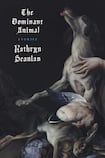
A woman cuts her hand while chopping onions. Chilled to the marrow, she passes out, having caught a glimpse of bone: “I saw it, white, swimming in the brimming gash.” This gory incident, which occurs in the collection’s concluding tale, recalls an earlier piece, where an obsessive hunter polishes animal bones “into gleaming white abstractions”. Lean and mean – whittled down to their very viscera – the 40 stories assembled in The Dominant Animal are certainly close to the bone.
As in her novel Aug 9 - Fog (2019) – carved out of a found text – Kathryn Scanlan seems to proceed not by addition but subtraction, like a sculptor chipping away at a slab of marble. “Ta-da!” (as its title advertises) turns this process into something of a joke. It closes – just as dusk darkens the neighbourhood “from the ground up, like dye climbing a cloth” – with an Old Testament-style bush giving birth to a figure. An arm, leg, and foot gradually emerge, while the female narrator looks on, entranced. “I’ve always been a sucker for origin stories,” she comments, “so I held my breath and waited to see how this one might begin.” Ending with a beginning (this is the last sentence) is a way of neither beginning nor ending, just like newborns in these pages never seem fully alive while the recently deceased never seem quite dead. It is a ruse to tap into the primal darkness while holding it at bay. The book itself ends on a similar, albeit more sinister, note: a shadow springing forth from a dark corner in the protagonist’s backyard, “like a vision of God, gnashing his great white teeth”.
Scanlan’s fiction never strays far from this point of origin that always threatens to reclaim it, as in this mystifying coup de théâtre: “For a while she could be seen in her white nightgown, but then the dark – it swallowed her.” Has the character really vanished, or is she simply obscured from view? The young American author’s audacious deployment of lacunae is a measure of her singular artistry.
Unsentimental approach
Although the setting is usually suburban, a “frontier kind of aroma” hangs over the manicured lawns. The nearby woodlands act as a kind of annexe of the id for the local menfolk: “It drew their blood. It drank their piss. It ate their shit. It hid the light of day. It hid the stars at night. It hid the path to town”. Scanlan’s unsentimental approach to the animal kingdom is exemplified by the vet who gelds a horse and tosses away “what he’d cut” to a pack of hounds, prompting them to fight over the “hot, wet heap”.
In the eponymous story, the female narrator notices a sculpture outside a church: two baby boys suckling at a she-wolf’s pendulous teats. This passing reference to Romulus and Remus is a reminder of civilisation’s pagan, animalistic roots. Animals and men are in fact so united in their bestiality that the slippage from the one to the other is almost imperceptible at times. Women suffer terrible abuse, but they give as good as they get, and some of the best stories are morality tales with a sting in their tails showcasing the author’s wicked sense of humour.
Scanlan claims that she either writes from the point of view of an alien or as though addressing one. The latter is achieved by shunning all forms of shorthand and cliché: the wealthy father in The Candidate is thus introduced as a “professional manipulator of spinal bones”. The wayward narrator of The First Whiffs of Spring – seemingly an alcoholic – embodies the former option. She attends a party but only understands why, when a “swaddled body” (note the characteristic obliquity) lands in her arms. Having described her elaborate outfit, highlighting the belt “upon which I’d set my hopes of pulling everything together”, she goes outside, where the wind reverses the process, dissolving her social persona: “It undid my hair and lifted my skirt. It scattered me just like I liked.”
The author’s focus on this scattered self and life stripped back to its essence does not result in a defamiliarisation of the world but, on the contrary, in its refamiliarisation – as though we were emerging from a coma. It also lends these tales a timeless quality, enhanced by a style that tends to the irrefutable. These are sentences written in stone – to be read out loud or learned by heart.
















